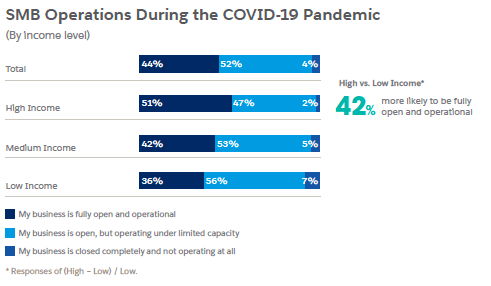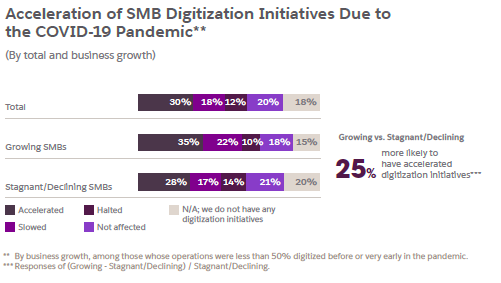Small and Medium Business (SME) trends have always been useful for understanding the thought processes of some of the world’s most creative business minds, yet SME trends have never been as important as they are at this moment. SME trends in 2020 provide insight into how businesses are adapting to a changing climate, approaching new challenges, and evolving to meet changing expectations. This is the year that everything changed – and businesses needed to change as well.
To find out what’s driving business trends today, Salesforce partnered with The Harris Poll to survey over 2,300 SME owners and leaders from across the globe. You can find the results in the 4th edition of the SME Trends Report, which you can download here.

A glance at the SME Trends Report reveals that many businesses have had to navigate unprecedented disruption, pivot quickly to address the changing market, and shift to new ways of working on the fly. Many organisations have been put under intense pressure by new rules and regulations, while others faced capital constraints, as entire industries ground to a halt. Despite this uncertainty, the data reveals that SME owners remain surprisingly optimistic. Not all SMEs will make it out of the other end of the tunnel, but the ones that do will discover a different world.
Let’s take a quick look at some of the insights from this report and see what it can tell us about the New Normal, the Next Normal and beyond.
SME trends show a new emphasis on safety and a shift towards digital interactions
After the pandemic hit, businesses had to accelerate their digital transformation processes. They also needed to put in place measures to ensure that they could keep their staff – and their customers – safe.
For many businesses, ensuring workplace safety and complying with health regulations are the top priority. According to our report, 64% of SMEs say that they’re focussing on safety and sanitation policies due to the Covid-19 pandemic, and 59% say that they’re emphasising local public health mandates. These are two concerns that wouldn’t have troubled SMEs at the same point last year, but are now tying up valuable time and resources when both are in short supply. Perhaps this is why so many SMEs are struggling with not only meeting these requirements, but also offsetting their effects.
Our SME Trends Report shows that 59% of SME leaders say that compliance with public health requirements creates excessive burden on their operability, and 65% say that the viability of their business is being threatened by local mandates to limit operations or close. With those numbers in mind, it should come as no surprise that 57% of SME leaders say that they’re struggling to keep their business afloat.
These business trends paint a bleak picture of the current landscape, so SME leaders must have a grim view of the future, right? Not so fast.
Disruptions remain, but optimism reigns
Despite the challenges and uncertainty of the past few months, many businesses have stabilised their operations and are now looking forward to moving on from the turbulence of 2020, armed with a new awareness of the importance of engaging their customers. It’s been a long year for everyone, but follow-up surveys found that companies are generally upbeat about their prospects for growth in the New Normal.
According to the SME Trends Report, 78% of SME leaders were optimistic about their business in 2019, 80% in March of 2020, and 72% in August 2020, despite the shockwaves of the pandemic upsetting the foundations of many businesses at that time. Moreover, the percentage of SME leaders that say they’re ‘not at all optimistic’ barely moved between March (4%) and August (5%). And even in the midst of the pandemic in August, over 4x as many SME leaders said they were ‘very optimistic’ than ‘not at all optimistic’ (22% vs 5%). In the UK/Ireland, 80% of SMEs say that they either expect to do business as usual, or with slight modifications, after the COVID-19 pandemic subsides. So despite the cloudiness of the current landscape, the majority of business leaders see blue skies and better days ahead.

Our report shows that one of the biggest challenges currently facing SME leaders when growing their business is acquiring new customers, with 44% of respondents listing this as one of their biggest challenges in March, and 48% of respondents in August. The current climate is all about providing personal and exceptional service, as lockdown measures led to a sea of new digital adopters, who now have sky-high expectations of anytime, anywhere service. For businesses that have yet to undergo digital transformation, connecting with these customers can be a hurdle, but it’s one that they need to overcome – and fast.
Digital is key, and will only grow in importance
In an age when staying connected with both employees and customers is key, SMEs who are growing are more likely to be focused on strengthening their digital capabilities than those who are stagnant or declining. Tech is a key differentiator between companies who can level up in the new climate, and those who are lagging behind. Digitally enabled companies have pivoted to provide customers with meaningful, personalised omnichannel experiences that aren’t reliant on brick-and-mortar shops and physical interactions. Companies that aren’t digitally mature, however, are struggling to meet increased customer expectations, equip remote workforces and provide connected experiences.
When comparing trends for growing companies with stagnant or declining ones, we can see how much of an enabler technology really is. Growing SMEs are more likely than stagnant or declining SMEs to say technology drives their customer interactions, the growth of their customer base, employee productivity, and cross-functional collaboration. Leaders of stagnant/declining SMEs, meanwhile, were more than twice as likely as growing SMEs to say that technology didn’t currently influence their business operations.
Those business trends are startling in their clarity: successful companies leverage technology to improve and evolve, while declining businesses don’t. There’s no such thing as a ‘magic bullet’ in the business world, but for SMEs looking to move into growth mode, the first part of the blueprint is clear.
SMEs are supercharging their customer communications
According to Salesforce’s Connected Customer survey, 66% of customers expect companies to understand their unique needs and expectations, and 77% say that this year’s crisis should be a catalyst for business improvement. In today’s climate, businesses that are standing still are falling behind.
With the rise in customer expectations, SMEs have turned to new, more personal ways of engaging. In fact, 55% of SME leaders have been more careful about their customer communications since the COVID-19 pandemic began, and nearly half (47%) have expanded the ways that customers can reach them, such as engaging on social media.
We also see a noticeable difference between how growing SMEs have changed for their customers, and how stagnant or declining SMEs do.
Growing SMEs are more likely to offer more flexibility and prioritise long-term relationships over one-off transactions. And here another piece of the blueprint for SME growth becomes clear.
Increasing resilience in an uncertain climate
The events of 2020 were sudden and jarring, and illustrated just how many companies weren’t prepared for a major crisis. Many SMEs won’t make that mistake again, and are now looking at ways to future-proof their operations against the next bout of turbulence. This involves everything from ensuring that staff can pivot easily to online working, to being able to recruit and retain top-performing employees. It also involves investing in digital solutions, as growing SMEs are 65% more likely than stagnant/declining SMEs to have accelerated the pace of their technology investments in the face of COVID-19.

When we step back and look at current business trends, we get a fairly clear picture of an unclear situation: Technology is enabling great transformations, as businesses evolve to be faster, more resilient and more agile than they were just a short time ago. Customer expectations are higher than ever, but growing SMEs are finding ways to meet them. Businesses have become more customer-centric and more personal, with many expanding their presence onto new channels. New ways of working have untethered the workforce, and new modes of operating have led to innovative solutions. Although the grey clouds of 2020 still hang overhead, they’re starting to part and let the light shine through.
To see how business trends are shaping the current SME landscape, download the 4th edition of the Salesforce SME Trends Report today.








